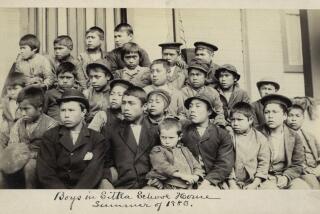TV Reviews : ‘White Man’s Image’ Thought-Provoking
“In the White Man’s Image,” tonight’s segment of “The American Experience” (at 9 p.m. on KCET Channel 28 and KPBS Channel 15, at 8 p.m. on KVCR Channel 24), is a small slice of history that illuminates some of the conflicts in the present-day battleground over multicultural, multiethnic sensibilities.
The show follows the efforts of Army Capt. Richard Pratt, founder of the Carlisle School for Indian Children in Carlisle, Pa., in 1879, to, in his words, “kill the Indian and save the man.” It is a chronicle of an experiment to raise the American Indian from a “savage” state, an experiment that stamped out their culture in the process.
Pratt began his work in 1875 with 72 captive Plains Indians transported to Ft. Marion in Florida. He had good intentions; he wanted to “reform these men under banishment.” Pratt changed their clothes and hair, remaking them in the white man’s image as he taught them to read, write and learn the white man’s ways. Three years later, the men were freed and Pratt was given the go-ahead by Congress to start his school.
At Carlisle, 169 children were brought from the Dakota Territory to study. They were forbidden to speak native languages, baptized and taught the value system of industrial America--learning competitiveness, individuality and so on. After graduation, most returned to the reservations, unable to make it in the outside world.
The show proudly wears its liberal bias on its sleeve, with all the usual problems. The Indians taken to Florida are always referred to as “warriors,” a form of mythologizing that--contrary to writer-producer Christine Lesiak’s intentions--actually dehumanizes them. And there is a question of balance: Is there really nothing good to be said about the 25 Carlisle-like schools that were eventually established in 13 states by Congress, schools that “educated thousands of Indian children in the white man’s way”? No success stories of graduates who made their way without losing their cultural heritage?
Nonetheless, “In the White Man’s Image” is thought provoking and often moving. Striking a balance between assimilation and ethnocentric militancy is an ongoing concern in the U.S. melting pot.
More to Read
The complete guide to home viewing
Get Screen Gab for everything about the TV shows and streaming movies everyone’s talking about.
You may occasionally receive promotional content from the Los Angeles Times.






